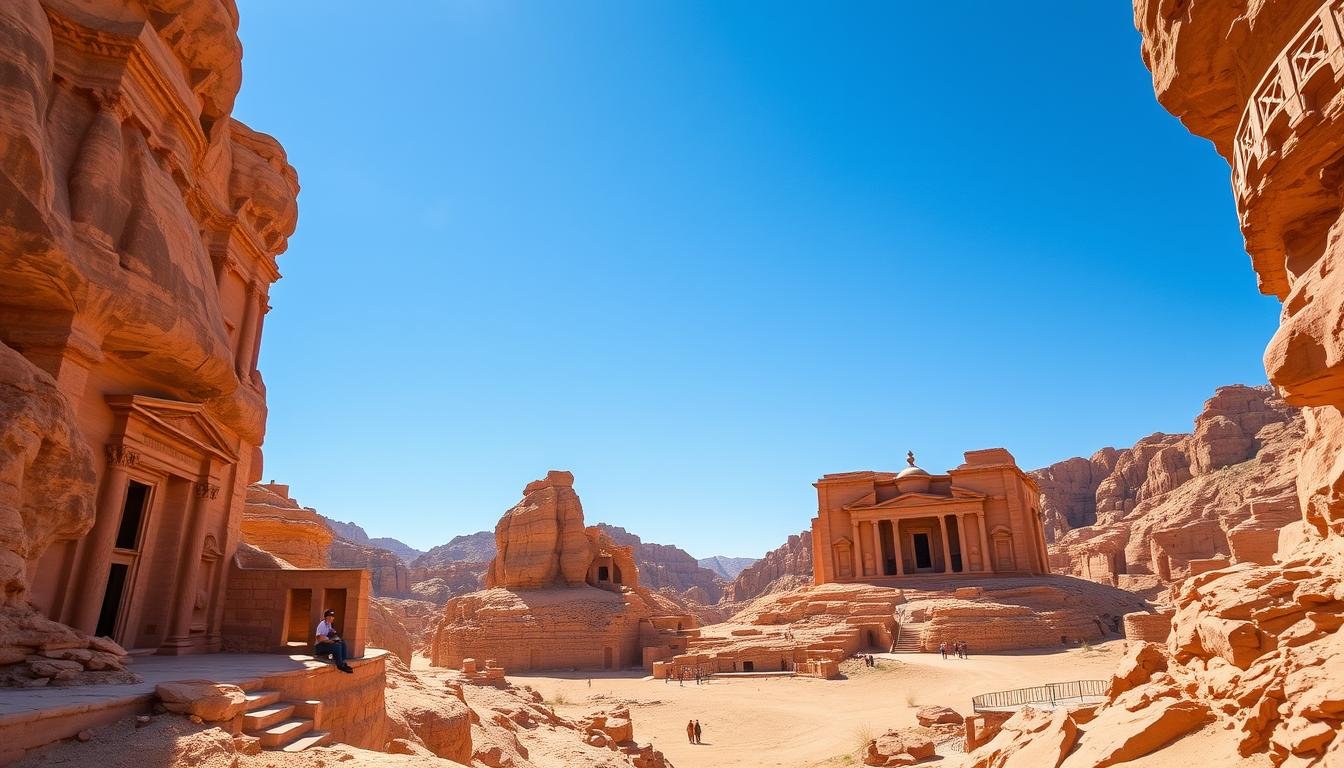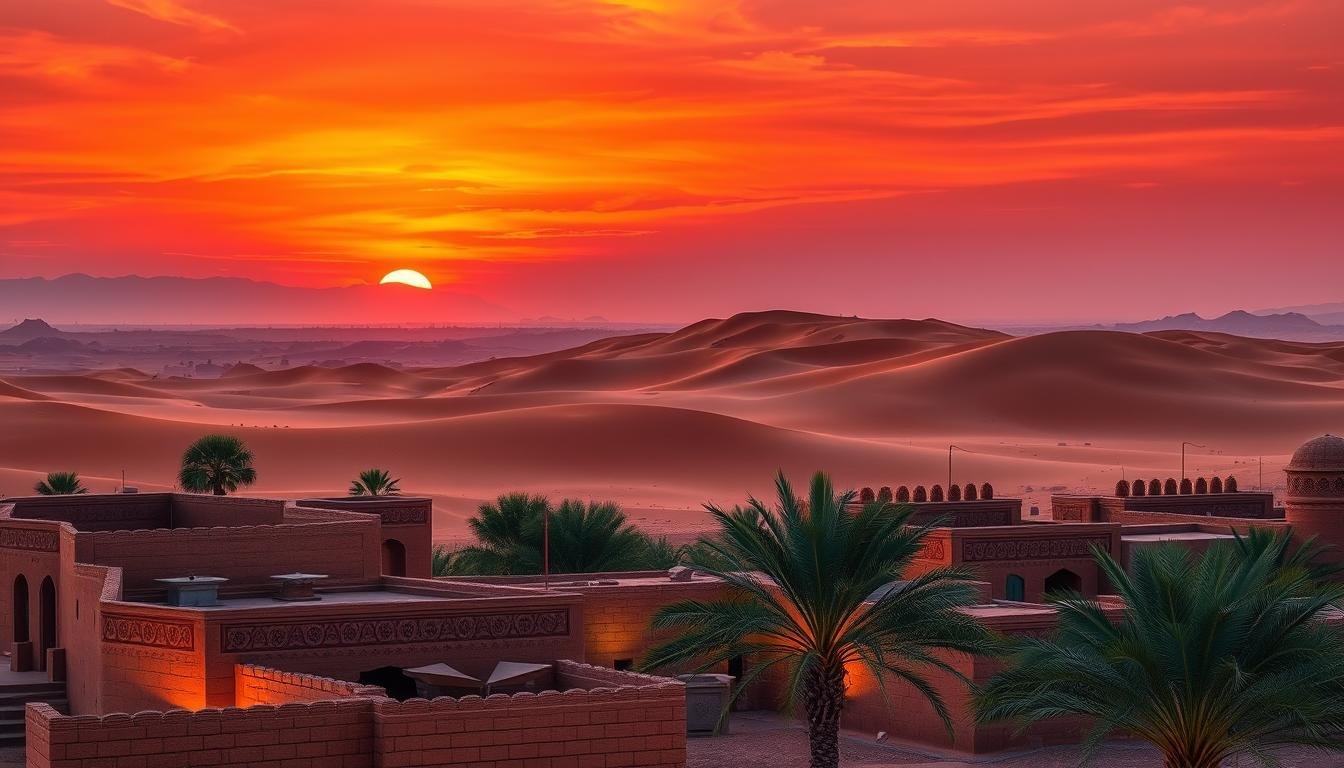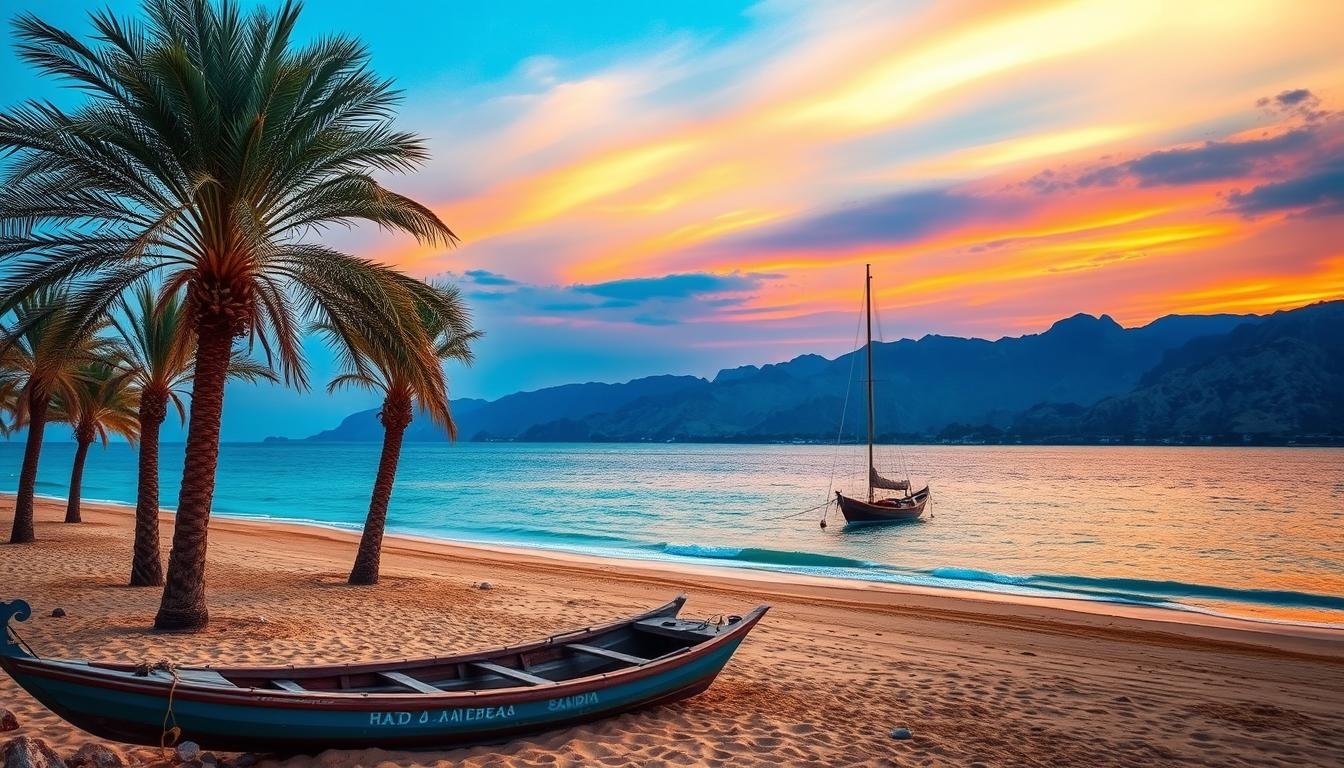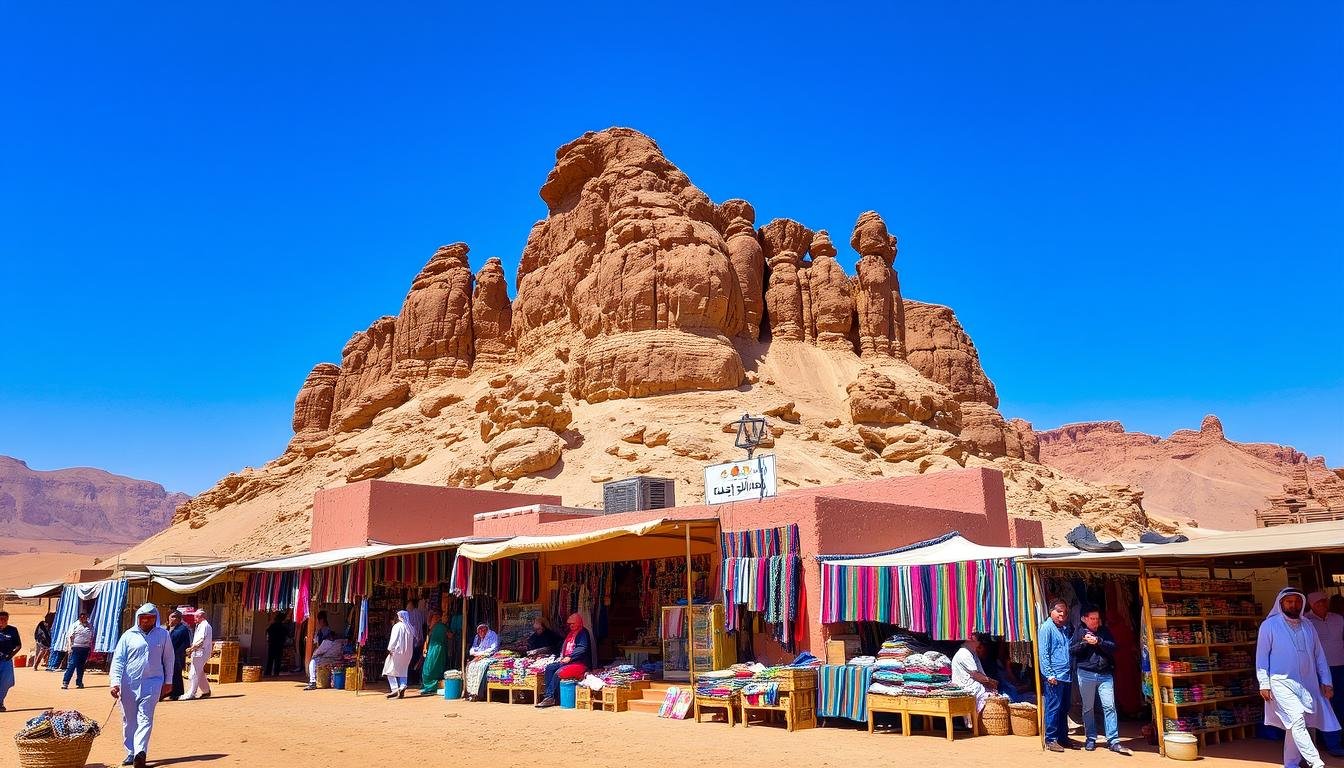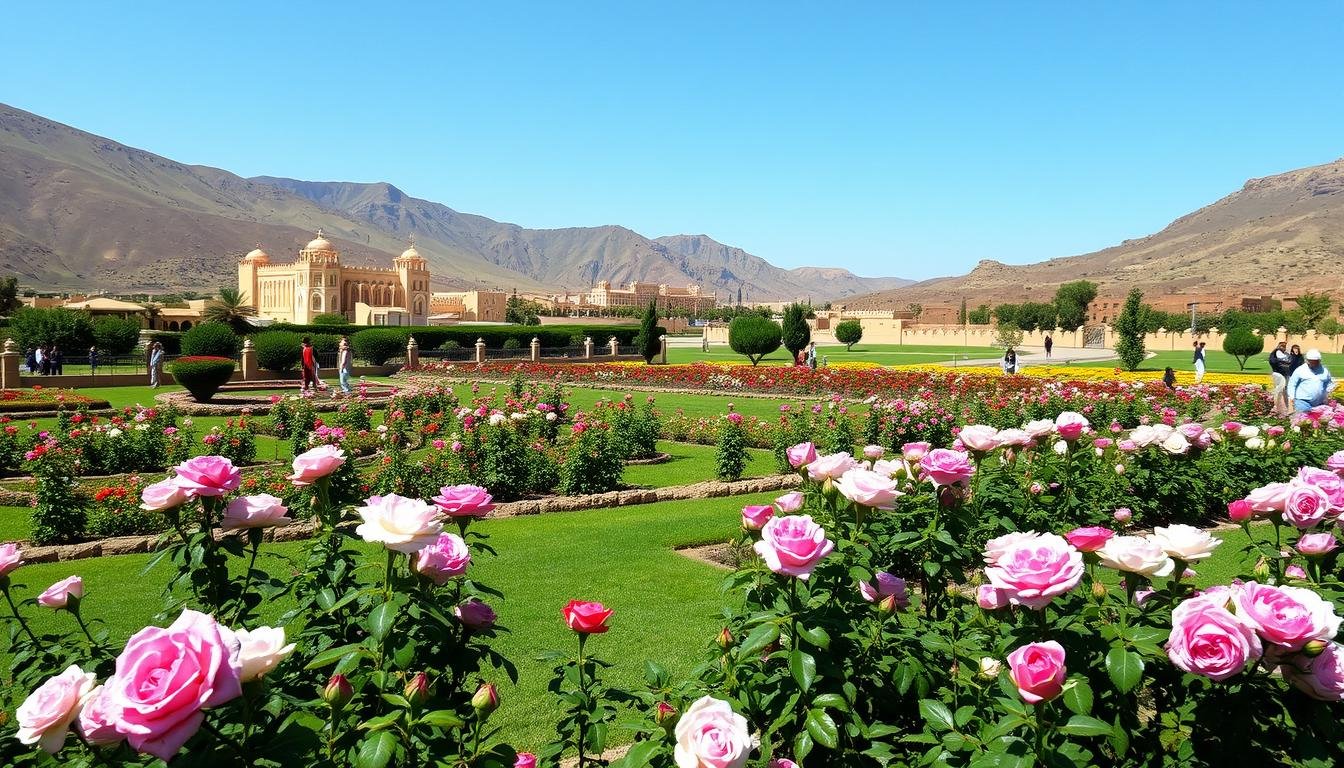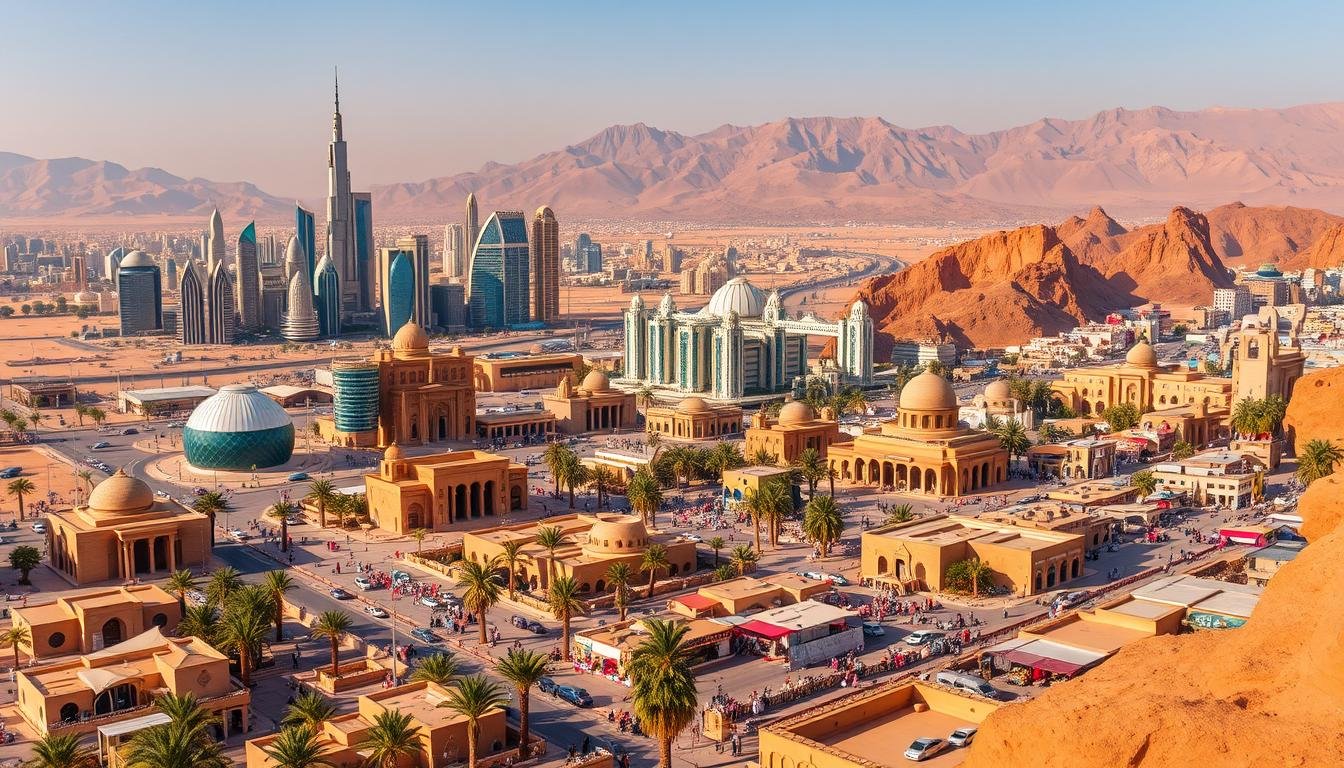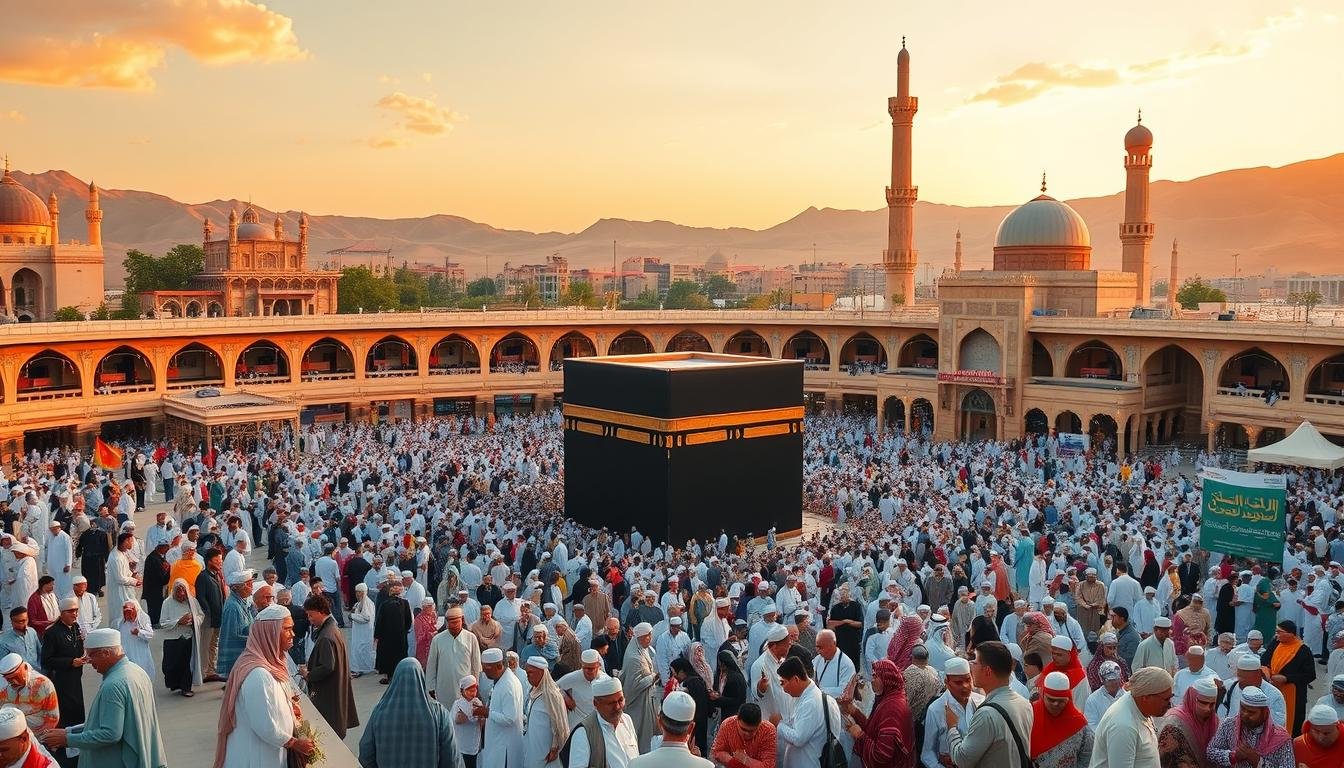Imagine walking where ancient civilizations once stood. The sands of time whisper their stories to you. Welcome to Saudi Arabia’s historic sites, where history comes alive.
As we start this journey, we wonder: What secrets do these monuments hold? How can they reveal Saudi Arabia’s past?
From Mada’in Saleh’s mysterious ruins to Jeddah’s UNESCO-protected district, Saudi Arabia’s sites are a treasure trove. Each place, carefully preserved, takes you back in time. It shows the triumphs and challenges of past generations.
Exploring these sites, we discover the stories that shaped the nation. We learn about Saudi Arabian identity and the values that have endured through time.
A Journey Through Time: Must-See Historic Sites in Saudi Arabia
Saudi Arabia is a land filled with history. It has ancient ruins, preserved antiquities, and archaeological marvels. These sites invite visitors to travel back in time. The kingdom’s history shows its lasting cultural heritage.
From Ancient Settlements to Modern Preservation
See the remains of ancient settlements across Saudi Arabia. They give us a peek into the lives of the earliest people here. These sites tell stories of the past that still echo today.
As you explore these wonders, you’ll see the hard work of those who protect them. They work to keep this cultural treasure safe for future generations.
Understanding Saudi Arabia’s Historical Timeline
- Prehistoric rock art and cave dwellings dating back thousands of years
- The rise and fall of ancient civilizations, including the Nabataean and Thamudic kingdoms
- The arrival of Islam and the establishment of the first Saudi state in the 18th century
- The unification of the kingdom under the House of Saud in the early 20th century
- Ongoing efforts to preserve and protect the country’s historical sites and artifacts
Dive into the story of Saudi Arabia’s past. Discover how history has shaped this land. From ancient ruins to today’s efforts, these sites offer a deep and enlightening journey.
Mada’in Saleh: The Ancient Nabataean City of Mystery
In northern Saudi Arabia, Mada’in Saleh is a hidden gem. It’s a UNESCO World Heritage Site known as Al-Hijr. This place is full of ancient ruins, including rock-cut tombs that amaze everyone who visits.
The Nabataeans, who lived from the 1st century BC to the 1st century AD, made Mada’in Saleh special. It was a key stop for the ancient incense trade. The site has tombs, temples, and water systems carved into sandstone.
The rock-cut tombs in Mada’in Saleh are truly impressive. They show off the Nabataeans’ skill in art and engineering. Each tomb is a masterpiece that takes you back in time.
Mada’in Saleh is connected to Petra in Jordan. Both show the Nabataeans’ ability to build in the desert. Petra is famous, but Mada’in Saleh is a hidden treasure waiting to be found.
Mada’in Saleh is protected as a UNESCO World Heritage Site. It’s a place where history comes alive. If you love history, archaeology, or just ancient wonders, you must see Mada’in Saleh.
The Historic District of Jeddah: A UNESCO World Heritage Site
The historic district of Jeddah, known as Al-Balad, is a treasure of Saudi Arabia’s rich culture. It’s a UNESCO World Heritage site, blending traditional Islamic architecture with deep historical value. This area is a vibrant mix of old and new, making it a must-see for anyone interested in history and culture.
Traditional Architecture and Design
Jeddah’s historic district is famous for its coral stone buildings. These structures, built centuries ago, show off the skill and creativity of local craftsmen. The narrow streets and wind towers, or “Malqaf,” are examples of ancient cooling techniques.
Cultural Significance Through Centuries
Jeddah’s historic district has been a key stop for Muslim pilgrims on their way to Mecca and Medina. Its location on the Red Sea coast made it a bustling commercial center. The area’s architecture and traditions reflect its diverse cultural heritage.
Modern Conservation Efforts
The Saudi government has been working hard to protect Jeddah’s historic district. They’ve launched restoration projects to keep the area’s unique world heritage sites, Islamic architecture, and cultural heritage alive for the future.
| Key Highlights | Details |
|---|---|
| UNESCO World Heritage Site | The historic district of Jeddah, known as Al-Balad, was designated as a UNESCO World Heritage site in 2014, recognizing its outstanding universal value. |
| Distinctive Coral Stone Architecture | The historic buildings in Jeddah’s Al-Balad district are renowned for their intricate coral stone designs, reflecting the region’s traditional building techniques. |
| Cultural Gateway for Pilgrims | Jeddah’s strategic location has made it a crucial gateway for Muslim pilgrims traveling to the holy sites of Mecca and Medina, contributing to its rich cultural significance. |
| Ongoing Conservation Efforts | The Saudi government has implemented extensive restoration and preservation projects to safeguard the historic district of Jeddah, ensuring its cultural heritage is maintained for future generations. |
Diriyah: The Birthplace of Saudi Arabia
Diriyah is a historic city in Saudi Arabia. It shows the nation’s rich culture and preserved history. It was the first capital of the Saudi dynasty, making it very special.
The At-Turaif District in Diriyah is a UNESCO World Heritage Site. It’s famous for its well-kept mud-brick buildings. These buildings date back to the 15th century, showing the skill of the region’s ancestors.
Diriyah is more than just old buildings. It’s where the modern Saudi Arabian identity started. The city played a big role in the nation’s politics and society.
People visiting Diriyah can dive into its history. They can see the mud-brick buildings and learn about the old ways of life. Keeping this heritage alive helps teach and inspire future generations.
| Significance of Diriyah | Key Highlights |
|---|---|
| First capital of the Saudi dynasty | At-Turaif District, a UNESCO World Heritage Site |
| Birthplace of the modern Saudi Arabian identity | Mud-brick architecture dating back to the 15th century |
| Emblem of the country’s rich cultural heritage and preserved antiquities | Integral role in shaping the nation’s political and social landscape |

The Rock Art of Jubbah and Shuwaymis
In the heart of Saudi Arabia’s desert, Jubbah and Shuwaymis rock art sites are treasures. They show the lively past of the Arabian Peninsula. These ancient petroglyphs, as UNESCO World Heritage Sites, fascinate scholars and visitors. They tell the stories of our ancestors who lived here thousands of years ago.
Prehistoric Petroglyphs
The rock art of Jubbah and Shuwaymis shows our prehistoric ancestors’ creativity. These detailed carvings on sandstone depict animals and humans. They remind us of the early people’s strength and ability to adapt to changing times.
Archaeological Significance
The Jubbah and Shuwaymis rock art sites are more than beautiful. They offer deep insights into the Arabian Peninsula’s culture, society, and environment. By studying these ancient ruins, researchers learn about the lives, customs, and beliefs of the past.
It’s crucial to protect these world heritage sites. They connect us to our shared human history. Exploring the rock art of Jubbah and Shuwaymis helps us appreciate the rich human civilization in the Arabian landscape.
The Ancient Oasis of Al-Ahsa
The Al-Ahsa Oasis is in eastern Saudi Arabia. It’s a big natural oasis and a key part of the kingdom’s history. It’s been a place of homes and farms for thousands of years. It’s a big preserved antiquity and a key part of Saudi Arabian tourism.
Historical Gardens and Springs
The Al-Ahsa Oasis has many historical gardens and springs. These have helped communities for generations. Visitors can see the cultural heritage of the area in these gardens.
Walking through these gardens is magical. The calm and the mix of water and greenery are amazing.
Traditional Agricultural Practices
The oasis is famous for its old farming ways. Farmers use special irrigation systems to grow many crops. These include dates, citrus fruits, and vegetables.
These farming methods are important for the cultural heritage and Saudi Arabian tourism. They attract visitors who want to see real, old farming practices.

| Key Highlights of the Al-Ahsa Oasis | Description |
|---|---|
| Largest Natural Oasis in the World | The Al-Ahsa Oasis covers an area of over 85,000 hectares, making it one of the largest natural oases on the planet. |
| UNESCO World Heritage Site | In 2018, the Al-Ahsa Oasis was designated as a UNESCO World Heritage site, recognizing its outstanding cultural heritage and historical significance. |
| Diverse Ecosystem | The oasis is home to a rich diversity of plant and animal life, including over 2.5 million palm trees and numerous freshwater springs. |
The Prophet’s Mosque in Medina: Islamic Heritage
The Prophet’s Mosque, also known as the Masjid al-Nabawi, is a sacred site in Medina, Saudi Arabia. It is a symbol of islamic architecture and cultural heritage. This mosque is a key part of the region’s history and culture.
This mosque was built where the Prophet Muhammad’s first mosque stood. Over time, it has grown to welcome more Muslim pilgrims. These expansions show the mosque’s importance in Islamic history.
- The mosque showcases a mix of architectural styles, from ancient Nabataean to Ottoman and Mamluk.
- The green dome over the Prophet’s tomb is famous worldwide.
- The large courtyard and tall minarets make the mosque impressive.
The Prophet’s Mosque is more than just a building. It’s a spiritual and cultural center for Muslims. It’s a place of pilgrimage, where people honor the Prophet and connect with their faith. This mosque is a key part of Islamic history and a must-see for those interested in islamic architecture and Saudi Arabia’s history.
Conclusion
As we wrap up our exploration of Saudi Arabia’s historic sites, it’s evident that this country is a treasure trove of culture and architecture. From the ancient Nabataean city of Mada’in Saleh to the UNESCO-recognized Historic District of Jeddah, Saudi Arabia has kept its heritage alive. It invites visitors to dive into a story that goes back thousands of years.
Diriyah, the birthplace of Saudi Arabia, shows the nation’s strength. The rock art in Jubbah and Shuwaymis tells us about ancient civilizations’ creativity. The oasis of Al-Ahsa and the Prophet’s Mosque in Medina highlight Saudi Arabia’s importance in the Islamic world. They show the country’s deep religious and cultural roots.
Thinking about the historical and cultural value of these sites makes me realize how crucial it is to protect and share this heritage. By supporting responsible tourism, we can keep Saudi Arabia’s wonders open to the world. This way, others can explore its history and appreciate its rich past. Saudi Arabia is dedicated to preserving and exploring its legacy, inspiring us all today and tomorrow.
FAQ
What are some of the must-see historic sites in Saudi Arabia?
In Saudi Arabia, you must see Mada’in Saleh and the historic district of Jeddah. Don’t miss Diriyah, the rock art of Jubbah and Shuwaymis, and the ancient oasis of Al-Ahsa. Also, the Prophet’s Mosque in Medina is a must-visit.
What is the significance of Mada’in Saleh?
Mada’in Saleh is a UNESCO World Heritage Site. It was a Nabataean city known for its rock-cut tombs. It’s called the “second Petra” because of its connection to Jordan’s famous site.
What makes the historic district of Jeddah a UNESCO World Heritage Site?
Jeddah’s Al-Balad district is a UNESCO World Heritage Site. It’s known for its coral stone architecture and as a gateway for pilgrims. Efforts are made to preserve this unique urban landscape.
Why is Diriyah considered the birthplace of Saudi Arabia?
Diriyah was the first capital of the Saudi dynasty. It’s seen as the birthplace of Saudi Arabia. The At-Turaif District, with its mud-brick architecture, played a key role in shaping Saudi identity.
What is the significance of the rock art sites of Jubbah and Shuwaymis?
Jubbah and Shuwaymis are UNESCO World Heritage Sites. They feature prehistoric petroglyphs. These petroglyphs give insights into early human settlements in the Arabian Peninsula.
What makes the Al-Ahsa Oasis a unique historical site?
The Al-Ahsa Oasis is one of the world’s largest natural oases. It has a rich history of gardens, springs, and traditional farming. These practices have supported communities for thousands of years.
What is the historical significance of the Prophet’s Mosque in Medina?
The Prophet’s Mosque in Medina is a key site in Islam. It has a long history, architectural changes, and great importance for Muslim pilgrims worldwide.
Don’t forget to share your experience in the comments and follow us on social media at the bottom of the site.
